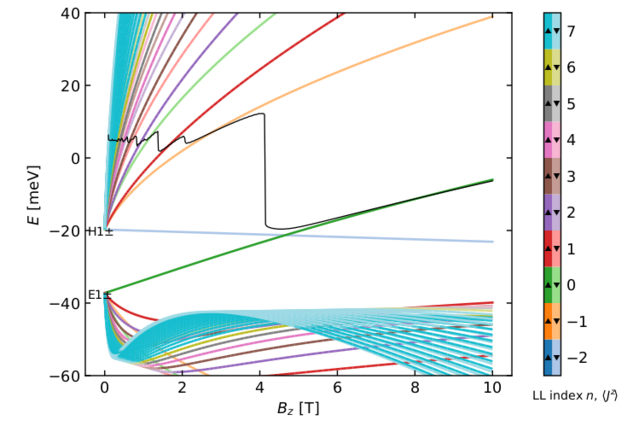Theory
Band structure theory
Band structure theory is the foundation of the theoretical understanding of electronic transport in semiconductor materials. The special properties associated with topology in materials like HgTe, are fundamentally rooted in the inversion of the bands at the Γ point.
The physics of zincblende materials like HgTe, CdTe, GaAs, etc. is described by the Kane model, a version of k·p theory that takes into account the eight atomic orbitals with energies close to the charge neutrality point. Unlike simplified theories such as the BHZ model which have limited use, k·p theory is widely applicable and is capable of predicting many aspects of topological insulator physics correctly, including transport physics and optical transitions.
In EP3/ITI, we simulate band structures by k·p theory with a self-developed Python application named kdotpy. The application is capable of calculating dispersions in bulk, slab, and strip geometries, and can produce Landau level fan charts. The latter can be plotted in terms of carrier density, so that the simulations can be straightforwardly compared to magneto-transport experiments. The calculation of optical transitions connects to the spectroscopic experiments (THz and Fourier-transformed infrared spectroscopy) by the Kießling group. This allows us to confirm and improve the input parameters of the k·p model. The predictive power of the code is also used for targeting MBE growth and sample fabrication. For the most demanding calculations, we use the high-performance computing cluster Julia HPC and we utilize GPU acceleration for an extra performance boost on suitable hardware.
We have released kdotpy as free open source software and we will keep developing it actively. We continue to improve the k·p parameters with input from spectroscopy (Kießling) and DFT (Sangiovanni).
More information:
Website: https://kdotpy.physik.uni-wuerzburg.de
Code repository: https://git.physik.uni-wuerzburg.de/kdotpy/kdotpy
Wiki: https://git.physik.uni-wuerzburg.de/kdotpy/kdotpy/-/wikis/home
Article: https://doi.org/10.21468/SciPostPhysCodeb.47
People
Collaborations
The development of kdotpy is done together with the groups of Hartmut Buhmann, Tobias Kießling, and Ewelina Hankiewicz. We also collaborate closely with the groups of Björn Trauzettel and Giorgio Sangiovanni.
Selected references
- W. Beugeling, F. Bayer, C. Berger, J. Böttcher, L. Bovkun, C. Fuchs, M. Hofer, S. Shamim, M. Siebert, L.-X. Wang, E. M. Hankiewicz, T. Kießling, H. Buhmann, and L. W. Molenkamp,
kdotpy: k·p theory on a lattice for simulating semiconductor band structures
SciPost Phys. Codebases 47 (2025)
-
Saquib Shamim, Wouter Beugeling, Jan Böttcher, Pragya Shekhar, Andreas Budewitz, Philipp Leubner, Lukas Lunczer, Ewelina M. Hankiewicz, Hartmut Buhmann, and Laurens W. Molenkamp
Emergent quantum Hall effects below 50 mT in a two-dimensional topological insulator
Sci. Adv. 6, eaba4625 (2020) -
David M. Mahler, Valentin L. Müller, Cornelius Thienel, Jonas Wiedenmann, Wouter Beugeling, Hartmut Buhmann, and Laurens W. Molenkamp
Massive and topological surface states in tensile-strained HgTe
Nano Lett. 21, 9869-9874 (2021) -
Wouter Beugeling
Parity symmetry as the origin of ‘spin’ in the quantum spin Hall effect
Phys. Rev. B 104, 115428 (2021) -
Li-Xian Wang, Wouter Beugeling, Fabian Schmitt, Lukas Lunczer, Julian-Benedikt Mayer, Hartmut Buhmann, Ewelina M. Hankiewicz, and Laurens W. Molenkamp
Spectral asymmetry induces a re-entrant quantum Hall effect in a topological insulator
Adv. Sci. 11, 2307447 (2024)
Ballistic transport and hydrodynamic flow
Over the past decade, there has been an increasing interest in studying of hydrodynamic electron transport. In the 1960s, Radii Gurzhi predicted that in pure materials where electron-electron scattering is the dominating scattering process, one should observe a decrease in resistance with increasing temperature. This phenomenon, the Gurzhi effect, involves the non-specular reflection of electrons from the boundaries of the conductor. The Gurzhi effect was first observed experimentally in a two-dimensional electron gas (2DEG) in GaAs [De Jong and Molenkamp, 1995].
The theoretical description of the Gurzhi effect is challenging, especially the inclusion of a perpendicular magnetic field. In EP3/ITI, we are developing a phenomenological model for the description of a Gurzhi-like effect in a channel in a GaAs 2DEG in a magnetic field, which we have observed in our transport experiments. This model directly utilizes the presence of edge conductivity channel (skipping orbits) in a sufficiently strong magnetic field, and explains why the Gurzhi effect disappears and reappears with increasing field.
The layered conductor PdCoO2 exhibits intriguing properties regarding the quasi-classical motion of conducting electrons. Due to its warped Fermi surface, the momentum direction of these electrons does not always align with their velocity direction. In experiments conducted at EP3/ITI, this phenomenon was shown to result in the emergence of an additional peak in non-local magneto-resistance. In the theory group, we are actively engaged in quasi-classical Monte Carlo simulations to model the motion of these electrons for calculating transmission coefficients for Landauer-Büttiker approach. Our simulations demonstrate a strong agreement with experimental observations. Moreover, we have discovered that incorporating momentum-relaxation processes into the simulation is crucial for explaining the non-zero resistance observed at high magnetic fields.
Given the inherent parallel nature of the calculations, the majority of our computational work is performed at the Julia HPC cluster.
People
Collaborations
We collaborate closely with the groups of Fakher Assaad and Björn Trauzettel.
Selected references
- M. J. M. de Jong and L. W. Molenkamp
Hydrodynamic electron flow in high-mobility wires
Phys. Rev. B 51, 13389 (1995)




